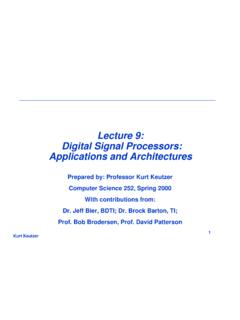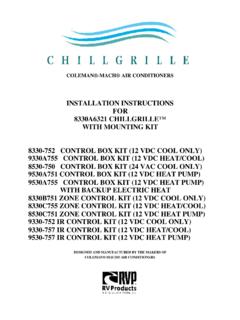Transcription of 16. DETERMINATION OF THERMAL CONDUCTIVITY
1 Chapter 16 Determinationt of THERMAL CONDUCTIVITY page 87 16. DETERMINATION OF THERMAL CONDUCTIVITY THERMAL conduction is the transfer of heat from one part of a body to another with which it is in contact. THERMAL CONDUCTIVITY is defined as ability of material to transmit heat and it is measured in watts per square metre of surface area for a temperature gradient of 1 K per unit thickness of 1 m. The THERMAL CONDUCTIVITY is not always constant. The main factors affected the THERMAL CONDUCTIVITY are the density of material, moisture of material and ambient temperature. With increasing density, moisture and temperature the THERMAL CONDUCTIVITY increases too. Important is inner structure of materials. Metals and other dense solid materials tend to have high levels of CONDUCTIVITY , whereas materials with very small amount of solid matter and large proportion of voids (gas or air bubbles, not large enough to carry heat by convection) have the lowest THERMAL conductivities.
2 THERMAL CONDUCTIVITY of some building materials is given in Tab.:37 Tab.:37 THERMAL CONDUCTIVITY of selected building materials ( at about 20 C) Material THERMAL CONDUCTIVITY ( W/mK ) air (dry and quiet) 0,023 PUR rigid foam 0, 02 0,04 expanded polystyrene 0,035 0,045 cellular glass 0,035 0,06 mineral or glass wool 0,04 0,08 particleboard 0,1 0,13 lightweight concrete 0,11 0,25 timber (pine) 0,14 water 0,60 brick 0,65 0,80 glass 0,6 1,38 concrete 1,2 1,75 limestone 1,50 granite 2,80 steel 43-58 aluminium and light alloys 125 200 copper 386 THERMAL CONDUCTIVITY Measuring Methods There are a number of possibilities to measure THERMAL CONDUCTIVITY , each of them suitable for limited range of materials, depending on the THERMAL properties and the medium general there are two basic techniques of measurement: the steady state technique performs a measurement when material that is analysed is in complete equilibrium. This makes the process of signals analysis very easy (steady state implies constant signals).
3 The disadvantage generally is that it takes a long time to reach the required equilibrium. Building Materials 10 - Testing Methods page 88 the non-steady state techniques perform a measurement during the process of heating up. The advantage is that measurements can be made relatively quickly. There are four main types of instruments available to measure THERMAL CONDUCTIVITY : guarded hot plate, hot wire, modified hot wire, laser flash diffusivity. They differ in technique, sample size, testing time, capability and methodologies of measurement. Guarded hot plate. A solid sample of material is placed between two plates. One plate is heated and the other is cooled or heated to lesser extent. Temperature of the plates is monitored until they are constant. The steady state temperatures, the thickness of the sample and the heat input to the hot plate are used to calculate THERMAL CONDUCTIVITY . The scheme of guarded hot place is at Fig.:46 Fig.:46 Scheme of guarded hot plate INSULATIONCOOLING PLATEHOT PLATESAMPLE OF MATERIAL Hot wire.
4 A heated wire is inserted into the material. The heat flows out radially from the wire into the sample and the temperature change in the wire is recorded. The plot of the wire temperature versus the logarithm of time is used to calculate THERMAL CONDUCTIVITY , provided that density and capacity are known. Since this is an intrusive measure, it cannot be used for solids; it works well for foams, fluids and melted plastics. The example of hot wire apparatus is at the Fig.:47 Modified hot wire. In this case, the hot wire is supported on backing, so the wire does not have to actually penetrate the sample. This modification allows for the testing of solid samples. Laser flash diffusivity. A laser flash delivers short pulse of heat to the front of the sample and an infrared scanner observes the temperature change at the rare face as a function of the time. Fig.:47 Scheme of measuring by apparatus ISOMET = 0,053 needle probeSample ofmaterialkeyboard display heat Chapter 16 Determinationt of THERMAL CONDUCTIVITY page 89 Determining of THERMAL CONDUCTIVITY in Steady State THERMAL CONDUCTIVITY in steady state is given by formula: [[[[]]]]W/mK T- Td q 21 ==== where q is quantity of heat passing through a unit area of the sample in unit time [W/m2] d distance between two sides of the sample [m] T1 temperature on warmer side of the sample [K] T2 temperature on the colder side of the sample [K] The quantity of transferred heat q is given by.
5 [[[[]]]]2W/m AQ q==== where Q is quantity of heat passing through a base area of the sample [W] A base area of the sample [m2] Temperature in the laboratory during the measuring should not vary more than 2 C and relative humidity should not exceed 65 %. Measuring of THERMAL CONDUCTIVITY by Dr. Bock s Apparatus This method is described in detail, because determining of THERMAL CONDUCTIVITY by this method is the part of laboratory lessons BM 10. This method belongs to the steady state methods, guarded hot plate and is convenient for measuring of solid materials. Scheme of Bock s apparatus is on the Fig.:48. Hot plate is circular with the diameter 160 mm and is heated electrically. Hot plate is embedded by the compensation plate, which serves as insulation of the hot plate and has the same temperature as the hot plate. Temperature in compensation and cooling plates is kept by water, running through two thermostats . For different materials is necessary to adjust proper intensity of heating to obtain steady state.
6 Fig.:48 Scheme of Dr. Bock s apparatus HEATING INTENSITYADJUSTMENTSUPPLYCONNECTIONCOMPE NSA-TION PLATETHERMOMETER HOT PLATETHERMOMETERCOOLING PLATETHERMOSTAT FORCOOLING PLATEWATERTHERMOSTAT FORHOT PLATEELECTROMETERTHERMOREGULATOR Building Materials 10 - Testing Methods page 90 Testing procedure: the test piece should have square plate or cylinder shape with one side (or diameter) 160 250 mm. The upper and lower surface has to be smooth and flat. place the test piece into the apparatus and measure its thickness by four micrometers and put on it insulating cover adjust rate of heating intensity according its size and material (by the nomogram, given by apparatus producer) switch on the heating and open water supply after some time check the temperatures of the water inlet and run-off on hot plate and cool plate and power consumption repeat reading until the temperatures and the consumption are stable the material is in the steady state after some interval read the temperatures and power consumption again and write down the values.
7 Repeat reading minimally three times. THERMAL CONDUCTIVITY is calculated from: [[[[]]]]mK/W o) -t ( ad Q ==== where Q is THERMAL performance of hot plate [W] d mean thickness of the sample [m] A hot plate area [m2] t THERMAL gradient between hot and cold plate [K] o correction of the THERMAL gradient about heat looses in apparatus [K] ==== TE 1000 Q w AQ o ==== where E is total power consumption [ ] T total time of measuring [hour] hot plate efficiency at given rate of heating intensity (Tab.:38) w apparatus constant Tab.:38 Values of hot plate efficiency Rate of heating intensity 1 2 3 4 5 6 7 8 9 10 11 12 Efficiency of hot plate 2,448 .10-3 3,591 .10-3 5,361 .10-3 7,886 .10-3 11,933 .10-3 17,726 .10-3 25,928 .10-3 38,295 .10-3 52,393 .10-3 79,466 .10-3 113,600 .10-3 160,546 .10-3 Vocabulary compensating plate kompenza n deska cooling plate chladic deska efficiency innost guarded hot plate chr n n tepl deska needle probe jehlov sonda non-steady state neust len stav steady state ust len stav THERMAL CONDUCTIVITY tepeln vodivost


